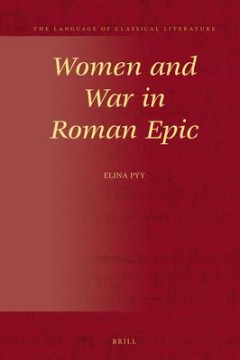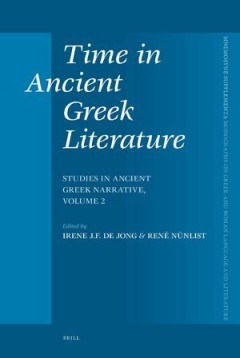Filter by

Advances in Oil Crops Research – Classical and New Approaches to Achieve Su…
The world production of main oil crops is steadily increasing, mainly due to population growth and increased use of oil crops in bio-fuel production and in edible vegetable oils. From the perspective of sowing area in the world, oil crops are only preceded by cereals in importance. Edible or industrial oils are extracted from seeds, fruits or mesocarp, and nuts of both annual and perennial s…
- Edition
- -
- ISBN/ISSN
- 9782889630684
- Collation
- 306
- Series Title
- -
- Call Number
- -

Accustomed to Obedience? Classical Ionia and the Aegean World, 480–294 BCE
Many histories of Ancient Greece center their stories on Athens, but what would that history look like if they didn't? There is another way to tell this story, one that situates Greek history in terms of the relationships between smaller Greek cities and in contact with the wider Mediterranean. In this book, author Joshua P. Nudell offers a new history of the period from the Persian wars to war…
- Edition
- -
- ISBN/ISSN
- 978-0-472-90387-0
- Collation
- oer.unej.ac.id
- Series Title
- -
- Call Number
- -

Understanding Turbulent Systems = Progress in Particle Dynamics Modeling
This open access book provides a thorough introduction to modeling turbulent, dispersed, two-phase flows. It explains the physical phenomena and governing laws at play, followed by a clear and systematic overview of the statistical tools used to develop simplified or coarse-grained models. With a pedagogical approach, the book uses practical examples to explain complex physical processes and…
- Edition
- -
- ISBN/ISSN
- 9783031844669
- Collation
- XIX, 284 hlm; ill., lamp.,
- Series Title
- -
- Call Number
- -

Urban Rituals in Sacred Landscapes in Hellenistic Asia Minor
In Urban Rituals in Sacred Landscapes in Hellenistic Asia Minor, Christina G. Williamson examines the phenomenon of monumental sanctuaries in the countryside of Asia Minor that accompanied the second rise of the Greek city-state in the Hellenistic period. Moving beyond monolithic categories, Williamson provides a transdisciplinary frame of analysis that takes into account the complex local hist…
- Edition
- -
- ISBN/ISSN
- 9789004461277
- Collation
- 540 hlm; ill., lamp.,
- Series Title
- Religions in the Graeco-Roman World, Volume: 196
- Call Number
- -

Women and War in Roman Epic
In Women and War in Roman Epic, Elina Pyy discusses the narrative and ideological functions of gender in the works of Virgil, Lucan, Statius, Silius Italicus and Valerius Flaccus. By examining the themes of violence, death, guilt, grief, and anger in their epics, she offers an account of the intertextual tradition of the genre and its socio-political background. Through a combination of classic…
- Edition
- -
- ISBN/ISSN
- 9789004443457
- Collation
- 342 hlm; ill., lamp.,
- Series Title
- The Language of Classical Literature, Volume: 33
- Call Number
- -

Left-Dislocation in Latin : Topics and Syntax in Republican Texts
Now available in Open Access thanks to the support of the University of Helsinki. In the construction known as left-dislocation, an element appears in a fronted position, before the clause to which it belongs, usually introducing the topic of the sentence. Based on a detailed analysis of syntax, information structure and pragmatic organization, this study explores how left-dislocation is used i…
- Edition
- -
- ISBN/ISSN
- 978-90-04-35746-4
- Collation
- x, 253 pp.
- Series Title
- Amsterdam Studies in Classical Philology, Volume: 28
- Call Number
- -

Lateinische Dialoge 1200-1400 : Literaturhistorische Studie und Repertorium
The Middle Ages produced a very considerable corpus of latin dialogues but until now a study of this group of texts was missing. In this monograph, the complete dialogue production of the years 1200-1400 (119 works, many of them still unedited) is explored and presented in a detailed repertory which gives title(s), incipit and explicit as well as information on author, date, textual transmissio…
- Edition
- -
- ISBN/ISSN
- 978-90-47-42063-7
- Collation
- xxx, 826 pp.
- Series Title
- Mittellateinische Studien und Texte, Volume: 37
- Call Number
- -

Inventing Origins? Aetiological Thinking in Greek and Roman Antiquity
Aetiologies seem to gratify the human desire to understand the origin of a phenomenon. However, as this book demonstrates, aetiologies do not exclusively explore origins. Rather, in inventing origin stories they authorise the present and try to shape the future. This book explores aetiology as a tool for thinking, and draws attention to the paradoxical structure of origin stories. Aetiologies r…
- Edition
- -
- ISBN/ISSN
- 978-90-04-50043-3
- Collation
- -
- Series Title
- Euhormos: Greco-Roman Studies in Anchoring Innovation, Volume: 2
- Call Number
- -

Tradition and Power in the Roman Empire = Proceedings of the Fifteenth Worksh…
This volume focuses on the interface between tradition and the shifting configuration of power structures in the Roman Empire. By examining various time periods and locales, its contributions show the Empire as a world filed with a wide variety of cultural, political, social, and religious traditions. These traditions were constantly played upon in the processes of negotiation and (re)definitio…
- Edition
- -
- ISBN/ISSN
- 9789004537460
- Collation
- 356 hlm; ill., lamp.,
- Series Title
- Impact of Empire, Volume: 50
- Call Number
- -

Time in Ancient Greek Literature = Studies in Ancient Greek Narrative, Volume 2
This is the second volume in a series of volumes which together will provide an entirely new history of ancient Greek (narrative) literature. Its organization is formal rather than biographical. It traces the history of central narrative devices, such as the narrator and his narratees,time, focalization, characterization, and space. It offers not only analyses of the handling of such a device b…
- Edition
- -
- ISBN/ISSN
- '9789047422938
- Collation
- 556 hlm; ill., lamp.,
- Series Title
- Mnemosyne, Supplements, Volume: 291
- Call Number
- -
 Computer Science, Information & General Works
Computer Science, Information & General Works  Philosophy & Psychology
Philosophy & Psychology  Religion
Religion  Social Sciences
Social Sciences  Language
Language  Pure Science
Pure Science  Applied Sciences
Applied Sciences  Art & Recreation
Art & Recreation  Literature
Literature  History & Geography
History & Geography